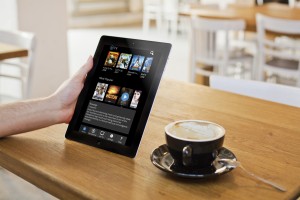Search and enjoy – developments in content search and discovery
Content search and discovery is fast becoming a differentiator among content providers, with new streaming devices helping to drive innovation. Andy McDonald reports.
In an increasingly fractured content world, the ability for viewers to search for programmes, films and clips, and to be offered contextually relevant content, is becoming more important than ever.
The evolution of the web, along with over-the-top video services including Netflix, Amazon and YouTube, has made mountains of content available at the click of a button. But with more choice than ever, the difficulty in sorting through this wealth of content is only more pronounced.
A new generation of web-connected TV devices – ranging from the Xbox One and PlayStation 4 games consoles to the Roku 3, Amazon Fire TV and Google Chromecast – are arguably helping to drive innovation in the search and recommendation field, with new functionality like voice control and universal search.
But how are traditional pay TV operators keeping pace of the changes in this space and to what extent is content discovery starting to define content providers’ offerings?
Searching across sources
California-based, web-streaming device firm Roku was founded by company CEO Anthony Wood back in 2002. Originally developed as the original video player for Netflix, Roku’s hardware and software has since gone through a number of iterations – the latest of which is a new line of Hisense and TCL-manufactured TVs with Roku’s operating system built in.
One major update, introduced in Roku boxes in the US at the end of 2012, was Roku’s universal search function – something that general manager of content and services Steve Shannon claims has been very popular. “It’s the idea of being able to search for a movie or an actor, a key word, and get results across the array of channels. So people can see where the titles are that they are interested in, which content partners on Roku have them and, if they cost money, how much they cost,” explains Shannon.
As well as saving users from having to click from app-to-app, the search function is designed to make it easier for users to compare the price of a particular piece of content – particularly in the transactional video-on-demand space – and Shannon says that Roku is “planning to continue to invest in that area and keep creating innovative ways for folks to navigate and quickly find that content.”
While Shannon claims Roku to be an innovator of sorts in the ‘universal search’ field, being “one of the first to do that kind of feature for the TV”, this functionality is now hardly unique to the firm – or even to web-based streaming services.
TV software and services firm SeaChange already takes a similar cross-sectional approach for Adrenalin, its multi-screen video platform for live linear TV, OTT and VOD, which is used by the likes of Liberty Global for its Horizon TV service.
“We have always envisioned that there is no difference between a linear event and an on-demand asset. We have always blended the two things together and basically stored them as a single entity in our back-office. That’s important from a content point of view, because we always had the vision that at some point the customer will not be as interested in browsing through a list of channels and events,” says SeaChange’s director of product management for EMEA and APAC, Peter Hahn.
“The search and recommendation feature is becoming more and more important because the fact that you have more content doesn’t mean that you can actually have access or even that you can explore it easier,” adds Hahn, referencing the firm’s search engine, which is based on the open source Lucene engine, and its partnership with search and recommendation specialists ThinkAnalytics.
Indeed, better search and recommendations are something that pay TV operators from across the TV space are increasingly keen to offer. In August this year, Sky in the UK introduced a number of new features for its Sky+ EPG, including a new recommendations engine. Like a number of its international counterparts, Sky’s new engine will suggest both linear TV and on-demand TV shows to Sky customers based on recent recordings and downloads in their Sky+ Planner.
UK rival Virgin Media has provided a suggestion and recommendation feature since it launched its TiVo offering in 2010. This also records programmes it thinks customers will like based on their viewing of other shows and movies, as well as taking into account programmes rated using a thumbs up and thumbs down feature.
Discussing the development of TiVo’s search and recommendation features over recent years, vice president and general manager of product marketing Jim Denney explains: “We have evolved search from a simple alphabetical search through the guide when the product was first launched to an (enterprise) customisable search that uses factors like popularity to influence results and searches across all content sources available to the user including OTT, OTA and cable sources.”
TiVo’s commitment to improving its underlying search capabilities can be seen in its February 2014 acquisition of discovery platform Digitalsmiths, which San Francisco-based Denney says “unlocks another level of personalisation and discovery capabilities” that will be incorporated into TiVo clients over time.
Denney also points to the TiVo iOS app that now lets users link to their Facebook and YouTube accounts so they can quickly access content that their friends are sharing or YouTube channels they subscribe to. “The key point is continuing to make discovery easier and to span all sources that are important to the user,” says Denney.
A change is going to come
Despite recent innovations, some industry watchers believe that there is yet to be a major breakthrough in the search and recommendation area. “There has never been so much content choice available to consumers so it follows that discovery and search is more important now than ever before,” says Steve Plunkett, chief technology officer of Ericsson-owned broadcast services firm Red Bee Media. However, Plunkett says there is still some way for the industry to go, as each provider “covets the role of default content gateway.”
“Search today tends to be either broad but of dubious quality or narrow but of limited scope. Each platform operator – including broadcaster catch up services – will offer sophisticated search across their own content domain but they rarely link to other providers, so performing a macro level or universal search relies on intermediaries,” says Plunkett.
Daren Gill, vice president of products at digital entertainment technology firm Rovi agrees. “There’s so much content that’s available now, the combination of all the linear channels with hundreds of thousands of titles available on VoD means at any one point in time you have millions of choices. That really means that the user interface breaks down if everyone has the same UI,” says Gill. He claims that though it is great if users are faced with interfaces that are personally and contextually relevant, typically these are still really a continuation of old legacy guides with siloed categories. This is part of the challenge that Gill and Rovi in general are grappling with.
Previously an executive at Massachusetts-based personalised entertainment discovery specialists Veveo, Gill joined Rovi when the firm bought Veveo out for US$62 million (€47 million) in cash earlier this year. With clients that included Verizon, AT&T and DirecTV, Veveo had worked across the TV guide space with an aim of moving towards more “personalised dynamic and contextually relevant” offerings. Combined, Gill says that the firms can bring together Veveo’s knowledge graph technology with Rovi’s metadata.
“We’ve taken editorial human curation and then we’ve added a sophisticated machine learning, scalable semantics on top of it,” says Gill, claiming its system is no longer static, but also “dynamic and contextual” and hence more powerful.
Gill says that for operators the “ultimate end-goal” is to have a profile for each user, but concedes that signing in to a TV is not pervasive behaviour. The best chance, he argues, of understanding individual behaviour is by having an understanding of mobile devices and second screens and having a robust system that can merge the data from that.
Gill says that for many operators it is still “a big deal for them to have one search bar that could cover title, actor, keyword, the role or any other semantic concept.” However, he adds that “when you talk about getting to that next level, bringing in recommendations or really trying to differentiate themselves, we found conversation has lately been the real driver. So everybody would like to get a voice-controlled interface and is moving towards that.”
This functionality is notable in that it is already available in a number of TV devices, but often from firms operating outside the traditional pay TV space. Microsoft’s Xbox One, for instance, when paired with its Kinect motion-sensor control, responds to voice commands, with users able to speak in order to switch to live TV, show the TV guide or select a channel. Similarly, Amazon’s Fire TV device, which launched in the US earlier this year, has voice search functionality that can be operated by pressing a button and speaking into a built-in mic on the remote control. However, as noted in early reviews of the device, this currently only supports search through Amazon’s native content library – not third-party apps.
Technology firm Piksel offers a video platform for online video and over-the-top TV services and its innovation labs are hard at work in the search and recommendation area. Kristan Bullett, Piksel’s global head of software architecture, says that after a year of development, the firm is focusing on pulling together an ecosystem that “crosses across multiple devices and then provides hyper-personalisation and is focused on behavioural patterns of the user.”
This context-based hyper-personalised product feeds into a broader vision of what Bullett believes will be a more intelligent and tailored version of TV recommendations in the future.
“At the moment we can determine various behavioural patterns, so we can know where you are, we can know what device you’re using. If we look at things like the Xbox or the Playstation, and Samsung smart TVs, they also have cameras in them, so they know who’s there. If you’re sat with the family, you might be watching very different content to if you’re sat on your own, for example. So we can determine that as well,” says . However, he concedes that a person’s mood, and the knock-on effect that has, is one factor that is very difficult to determine.
New innovation
In terms of devices including Roku and Apple TV, Bullett believes that these are driving innovation in the sense that apps can be developed and deployed very quickly, reversing the often cumbersome process involved in updating traditional pay TV services. “If we look at the way that set-top box development works, it’s a multi-year development and then an 18 month field-test process before it goes to market,” he says.
However, not everyone is as convinced. TiVo’s Denney, claims that while devices like Google’s Chromecast are good at delivering access to “pieces of content,” they don’t provide access to “the most popular form of content,” which is pay TV. He claims that by blending content from different sources, TiVo is essentially combining services that are provided separately by Amazon Fire TV, Apple TV, Roku, Sling, a cable box, and DVR – all in one box.
One debate that is still important when it comes to assessing what search and recommendation features, and general [icitspot id=”261062″ template=”box-story”]TV user interfaces, will look like in the future concerns the idea of the TV as a “dumb panel.” In this scenario, the content providers will hope to continue to own the customer experience through their own hardware or software offerings.
However, this is something that the TV manufacturers are railing against, as seen in the increasingly sophisticated features of smart TVs by the likes of Samsung, LG and Sony – with even more players now looking to take a piece of this market. The new low-price Roku-powered TV sets from Hisense and TCL are one example of an electronics manufacturer stamping its own user experience on the device, with Google another prime example of a firm looking to make waves in this space.
While Google’s previous Android-powered TV efforts have failed to catch the attention of mainstream consumers, at its I/O developers conference in San Francisco in June Google made a fresh play at this space, announcing Android TV – a new “form factor” for Android.
“My goal internally at Google is that no one talks about Android TV in a year, that it’s just assumed,” said Android TV engineering manager Chris McKillop speaking on-stage at the event. “No one talks, really, about Android tablets and phones – it’s just Android. That’s what I’m trying to accomplish [with Android TV].”
Outlining to developers the features of the new TV-optimised version of its Android operating system, McKillop stresses the need for voice control, saying “we’re really pushing hard on all the hardware OEMs to have microphones in all their devices.” Unsurprisingly, intelligent search and recommendation is also at the heart of Google’s Android TV vision. Search will appear at the top of the screen, while the goal is to provide users with a content recommendation stream taken from a variety of sources.
Put in a nutshell, Android TV’s head UX designer Leo Baghdassarian describes the experience that many in the TV space are striving for: “We wanted a home screen that gave you quick access to a blend of content from the sources you use most, one that encouraged the simple leanback browsing and serendipitous discovery, and that got to know you and made it easier to access your most-used apps and games. Ultimately one that felt immersive and engaging.”
In an increasingly convoluted world of content options, it is the players that nail this ease of use that will benefit from customer loyalty in years to come.




